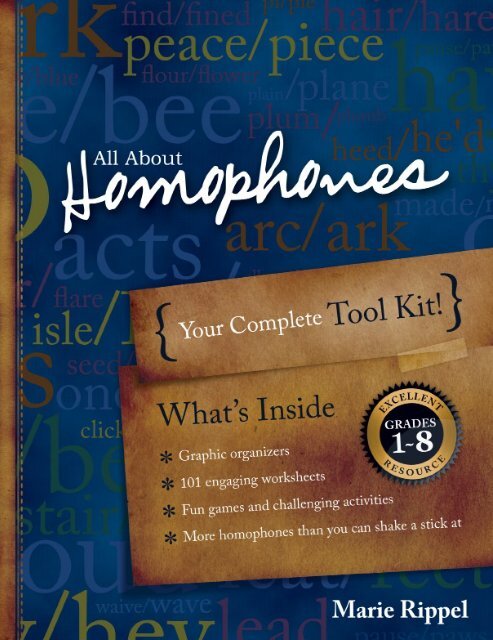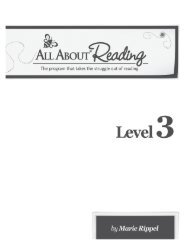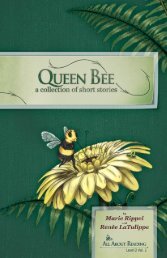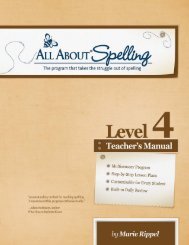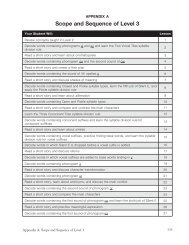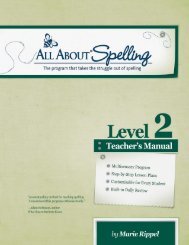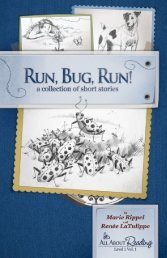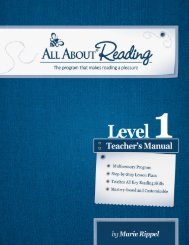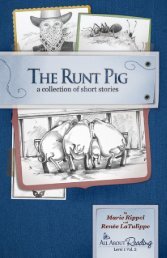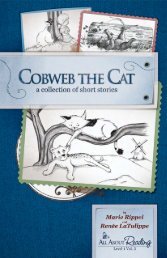Download sample (PDF) - All About Learning Press
Download sample (PDF) - All About Learning Press
Download sample (PDF) - All About Learning Press
Create successful ePaper yourself
Turn your PDF publications into a flip-book with our unique Google optimized e-Paper software.
Table of Contents<br />
Introduction to Homophones .......................................................................................................................................................9<br />
Graphic Organizers<br />
Using Graphic Organizers ..........................................................................................................................................15<br />
Selection of Graphic Organizers .............................................................................................................................16<br />
Homophone Worksheets<br />
Suggestions for Using the Worksheets .................................................................................................................25<br />
List of Homophone Worksheets ..............................................................................................................................26<br />
Worksheets ...........................................................................................................................................................................27<br />
Crossword Puzzles .............................................................................................................................................................................141<br />
Homophone Card Games<br />
Using Games to Teach Homophones .................................................................................................................163<br />
Pig ...........................................................................................................................................................................................165<br />
Go Fish .................................................................................................................................................................................166<br />
Old Maid .............................................................................................................................................................................167<br />
Homophone Pile-Up ...................................................................................................................................................168<br />
Homophone Memory Game ....................................................................................................................................169<br />
Snap! ......................................................................................................................................................................................170<br />
Game Cards ........................................................................................................................................................................171<br />
More Teaching Tools<br />
Teaching Homophones with Books .....................................................................................................................199<br />
Student Record Sheets ................................................................................................................................................201<br />
Tongue Twisters ............................................................................................................................................................204<br />
Riddles .................................................................................................................................................................................212<br />
Puns .......................................................................................................................................................................................213<br />
Appendices<br />
Appendix A: Worksheet Answer Keys .................................................................................................................217<br />
Appendix B: Crossword Answer Keys ................................................................................................................225<br />
Appendix C: Homophones Used in Activities ..............................................................................................229<br />
Appendix D: Mega-List of Homophones .........................................................................................................231<br />
Bibliography ........................................................................................................................................................................................239
Introduction to Homophones<br />
I can still remember the day I first found out about homophones. My second grade teacher had a small<br />
collection of books on a low shelf in the back of the classroom. After we were done with our work we could<br />
choose a book and bring it back to our desks. One day I discovered a book that had pairs of homophones. It<br />
was the first time I realized that such things existed and my pulse quickened. The thrill of such knowledge!<br />
I read that book over and over, and to this day I still like these pairs of words!<br />
The fact is, many students find homophones interesting. You can capitalize on this interest and use<br />
homophones to teach reading, writing, and vocabulary. Lessons that include homophones provide the<br />
perfect opportunity to play with words and have some fun with language.<br />
What are homophones?<br />
Homo means same and phone means sound, so the word<br />
homophone literally means same sound. Homophones<br />
are two or more words that sound alike but that are<br />
spelled differently and have different meanings. Sets<br />
of homophones include billed and build, peace and piece,<br />
and sew, so, and sow.<br />
Homophones occur in English because we have multiple<br />
ways to spell the same sound. For example:<br />
*<br />
*<br />
*<br />
The sound of /n/ can be spelled with the letter<br />
n or the letter combination kn, resulting in the<br />
homophones night and knight.<br />
The sound of /ā/ can be spelled a-consonant-e<br />
or ay (among other possible spellings), giving<br />
us daze and days.<br />
The schwa sound (the muffled /uh/ sound of<br />
vowels in unaccented syllables) causes words<br />
like complement and compliment to be pronounced<br />
alike.<br />
A note about regional accents<br />
Regional accents can affect whether words are homophones or not. A few words are homophones in some<br />
areas but not in others. For example, weather and whether are pronounced the same in certain parts of<br />
America, but in other regions the wh in whether has retained a distinct /hw/ sound. The words acts and ax<br />
sound alike to most of us, but some people pronounce the t in acts.<br />
Speakers in the U.S. pronounce due and do identically, but in most British accents they are pronounced<br />
differently. The words boy and buoy have the same pronunciation in England (and therefore are<br />
homophones) but not in America.<br />
As you use the activities in this book, you should be the final judge as to whether certain word pairs are<br />
homophones in your neck of the woods.<br />
www.<strong>All</strong>-<strong>About</strong>-Homophones.com<br />
9
What you’ll find in this tool kit<br />
Graphic Organizers<br />
These organizers provide room for creativity and<br />
individual expression as students learn the meanings of<br />
new homophones.<br />
Homophone Worksheets<br />
Much more interesting than your average worksheets!<br />
These pages provide ideas for creative reinforcement,<br />
including activities that will get your students thinking,<br />
reading, writing, and speaking. They provide learners an<br />
opportunity to practice new skills in order to truly master<br />
them.<br />
Crossword Puzzles<br />
Provide your students with extra reinforcement with these<br />
homophone puzzles. Clever graphics and riddles add an<br />
element of humor.<br />
10 www.<strong>All</strong>-<strong>About</strong>-Homophones.com
Card Games<br />
The intellectual stimulation provided by games keeps kids<br />
learning and making new connections between words.<br />
Instructions and game cards for six quick, motivating<br />
games are included.<br />
And More!<br />
Capture the attention of your students with these<br />
additional resources:<br />
*<br />
*<br />
Teaching Homophones with Books<br />
Student Record Sheets for Recording Personal<br />
Lists of Homophones<br />
Tongue Twisters<br />
Riddles and Puns<br />
Mega-List of Homophones<br />
Dip into this book often and use the wide variety of activities to enhance your lessons!<br />
www.<strong>All</strong>-<strong>About</strong>-Homophones.com<br />
11
Using Graphic Organizers<br />
Graphic organizers are a great way to teach homophones to children. There are many benefits to using<br />
these graphic organizers.<br />
*<br />
*<br />
*<br />
Graphic organizers help communicate information through charts and diagrams.<br />
They help sharpen analysis and communication skills.<br />
Students learn the meaning of the homophone when they fill in the definition.<br />
Students have the opportunity to practice using the homophones in original sentences.<br />
There is room for creativity and individual expression, which can help students remember the<br />
homophones more easily.<br />
Organizing information makes it easier for students to grasp the differences between homophones.<br />
The organizers promote a sense of student ownership of knowledge because they replace teachergenerated<br />
sheets with student-generated writing.<br />
Graphic organizers offer students a hands-on approach to learning new words.<br />
Here are some ideas for using graphic organizers in the classroom:<br />
*<br />
*<br />
Have students fill in their own graphic organizers so that each student’s sheet is unique.<br />
Students can decorate their work with crayons or colored pencils.<br />
Completed graphic organizers can be used as a study aid for spelling, reading, and vocabulary.<br />
Use the organizers as an assessment tool.<br />
Store the organizers in a classroom binder (like a class book) or keep them in individual student<br />
portfolios. Students can punch holes in them and place in a three-ring binder.<br />
Encourage students to come up with their own sentences using the homophones.<br />
When teaching a new set of homophones to your students, draw a graphic organizer on the<br />
chalkboard or dry erase board. Fill in the different sections as you discuss them with your<br />
students.<br />
Following are six graphic organizers that you can copy and use with your students.<br />
www.<strong>All</strong>-<strong>About</strong>-Homophones.com<br />
15
16 www.<strong>All</strong>-<strong>About</strong>-Homophones.com
18 www.<strong>All</strong>-<strong>About</strong>-Homophones.com
Suggestions for Using the Worksheets<br />
Worksheets give students targeted practice with the proper use of homophones. Each fill-in-the-blank<br />
worksheet in this section features a single set of homophones. Answer keys for the worksheets are located<br />
in Appendix A.<br />
For ease in locating the homophone pairs you want to teach, worksheets are arranged in alphabetical<br />
order within each suggested grade level section. <strong>All</strong> homophones are also cross-referenced with page<br />
numbers in Appendix C.<br />
At the bottom of each worksheet you will find fun facts, tongue twisters, writing activities, and other nifty<br />
features that will help reinforce the homophones learned. In addition, the worksheets offer a jumpingoff<br />
point for many other creative activities that will get your students thinking, reading, writing, and<br />
speaking. Here are a few more ideas you can try:<br />
Vocabulary<br />
*<br />
Teach the meanings of the homophones before handing out the worksheet.<br />
Use the graphic organizers to teach definitions and to list synonyms.<br />
Have students circle other unfamiliar words in the sentences and look up definitions.<br />
Creative Writing<br />
*<br />
*<br />
Use the worksheets to teach literary devices such as rhyme, simile, alliteration, assonance, and<br />
meter.<br />
Students can use the homophone pairs to create their own tongue twisters, riddles, songs, and poems.<br />
Have students choose a sentence from the worksheet and use it as a writing prompt for a brief<br />
story, poem, or descriptive paragraph. Encourage them to use the targeted homophones and<br />
their imaginations.<br />
Reading and Research<br />
*<br />
Use the Fun Facts! and Try This! features to encourage further reading and research on a topic<br />
suggested in the sentences.<br />
Speaking<br />
*<br />
*<br />
Art/Drama<br />
*<br />
*<br />
Write the homophone pairs on the board and use the sentences to hold a classroom Homophone<br />
Bee.<br />
Project the worksheets on the wall and call on students individually to provide the correct word.<br />
Have students recite their original tongue twisters, poems, sentences, and so on.<br />
Have students draw pictures of the homophone pairs and label the pictures with the correct<br />
words.<br />
Create a homophones bulletin board with student-generated art and writing.<br />
Have students act out a homophone for the rest of the class to guess and spell.<br />
Students can write and perform silly skits using designated homophone pairs.<br />
Reinforcement<br />
*<br />
Use the crossword puzzles and games included in this book to review homophones learned.<br />
Have students write their own fill-in-the-blank sentences and use them to “quiz” their<br />
classmates.<br />
www.<strong>All</strong>-<strong>About</strong>-Homophones.com<br />
25
oad & rode<br />
Fill in the blanks with the correct word: road or rode.<br />
1.<br />
2.<br />
3.<br />
4.<br />
5.<br />
6.<br />
7.<br />
8.<br />
9.<br />
10.<br />
This _______________ has twists and turns, so fasten your seatbelt.<br />
Ted _______________ the roller coaster until he was dizzy.<br />
The cowboys _______________ their horses to the end of the dirt _______________.<br />
Sue was lost and didn’t know which _______________ to take.<br />
Alex _______________ his bike in the parade.<br />
The Roman soldiers _______________ on the old stone _______________ until the break<br />
of dawn.<br />
I _______________ an elephant at the circus last week!<br />
The tribe _______________ their camels across the desert.<br />
The scarecrow danced down the Yellow Brick _______________.<br />
There’s a moose in the middle of the _______________!<br />
Fun Facts!<br />
How old is the street you live on? One of the oldest paved roads in the world is in Egypt. Built 4,600<br />
years ago, it is about seven miles long and is located near the Great Pyramids of Giza. In Italy, the<br />
Aurelia road was built between ancient Rome and Pisa over 2,000 years ago—and is still used today!<br />
50 www.<strong>All</strong>-<strong>About</strong>-Homophones.com
sale & sail<br />
Fill in the blanks with the correct word: sale or sail.<br />
1.<br />
2.<br />
3.<br />
4.<br />
5.<br />
6.<br />
7.<br />
8.<br />
9.<br />
10.<br />
If there is a _______________ on worms, would you buy me fourteen of them?<br />
We are ready to _______________ as soon as the storm stops.<br />
My mom made cupcakes for the bake _______________ .<br />
We bought this _______________ on _______________, but it’s full of holes.<br />
Why does she always _______________ into class five minutes late?<br />
Every video game in the store was on _______________ today.<br />
We heard the crack of the bat and watched the ball _______________ through the air.<br />
Let’s _______________ around the island and go to the seashell _______________ on the<br />
other side.<br />
The pirates planned to _______________ away in the dead of night.<br />
They heard there was a _______________ on eye patches and didn’t want to miss it.<br />
Silly Sentences!<br />
Make up your own silly sentences using the homophones sale and sail. Try to start most of the words<br />
with the letter s.<br />
__________________________________________________________________________________________________________<br />
__________________________________________________________________________________________________________<br />
www.<strong>All</strong>-<strong>About</strong>-Homophones.com<br />
51
pale & pail<br />
Fill in the blanks with the correct word: pale or pail.<br />
1.<br />
2.<br />
3.<br />
4.<br />
5.<br />
6.<br />
7.<br />
8.<br />
9.<br />
10.<br />
Wild rabbits hopped in the _______________ light of dawn.<br />
He dragged that heavy _______________ of rocks for three miles.<br />
Why did Peter put his peppers in a _______________?<br />
Sue turned _______________ when she saw that her _______________ was empty.<br />
They crept along the wooded path, lit only by a _______________ moon.<br />
She looked like a rosebud in her _______________ pink dress.<br />
Alan poured a whole _______________ of berries on his pancakes.<br />
Bobby asked me to fill this _______________ with _______________ green bugs.<br />
Jill woke from her nightmare, _______________ with fear.<br />
“I dreamed I dropped my _______________ of water,” she wailed.<br />
Pun Play!<br />
A pun is a humorous play on words that uses homophones or words with multiple meanings. Can<br />
you figure out the pun in the riddle below?<br />
Q. Why was the pail pale?<br />
A. It wasn’t a well bucket.<br />
68 www.<strong>All</strong>-<strong>About</strong>-Homophones.com
capital & capitol<br />
Fill in the blanks with the correct word: capital or capitol.<br />
1.<br />
2.<br />
3.<br />
4.<br />
5.<br />
6.<br />
7.<br />
8.<br />
9.<br />
10.<br />
Katy kept quiet about her secret location in the _______________ city.<br />
With a whoosh of his cape, Superman flew to the top of the _______________.<br />
Use a _______________ letter when you write about the _______________ building.<br />
“What a _______________ idea!” bellowed the jolly old soul.<br />
Eagle River, Wisconsin claims to be the “snowmobile _______________ of the world.”<br />
She whispered the code word and the doors to the _______________ swung open.<br />
Was it a __________ offense to eat corn on the cob on the steps of the state ___________?<br />
She baked a cake in the shape of the ______________ building for the lawyer’s birthday.<br />
Why did the senator crawl into the _______________ on his hands and knees?<br />
The cackling cats in their camel coats committed a _______________ error.<br />
Fun Facts!<br />
Hollywood may be the movie capital of the world, but lots of other American cities claim to be the<br />
“capital of the world” for something, too. Take a look at these:<br />
• Bandera, Texas – Cowboy Capital of the World<br />
• Kennett Square, Pennsylvania – Mushroom Capital of the World<br />
• Sheboygan, Wisconsin – Bratwurst Capital of the World<br />
• Parke County, Indiana – Covered Bridge Capital of the World<br />
• Coconut Creek, Florida – Butterfly Capital of the World<br />
• Beaver, Oklahoma – Cow Chip Throwing Capital of the World<br />
www.<strong>All</strong>-<strong>About</strong>-Homophones.com<br />
129
Two Pears<br />
Across<br />
3<br />
5<br />
6<br />
9<br />
10<br />
way up in the air<br />
the color of the sky<br />
one penny<br />
Jim _____ a horse yesterday.<br />
I _____ her name.<br />
Down<br />
1<br />
2<br />
3<br />
4<br />
5<br />
7<br />
8<br />
what you say when you greet someone<br />
I can’t believe he ate the _____ pizza!<br />
an opening or gap where something<br />
is missing<br />
She _____ a letter to her pen pal.<br />
The big bad wolf _____ the house down.<br />
opposite of old<br />
what you drive a car on<br />
Word Bank<br />
road<br />
whole<br />
blew cent hi new hole<br />
blue knew rode high sent<br />
Riddle:<br />
What do you call two pears?<br />
A pear pair.<br />
146 www.<strong>All</strong>-<strong>About</strong>-Homophones.com
Sir Lancelot<br />
Across<br />
4<br />
5<br />
6<br />
9<br />
11<br />
12<br />
13<br />
painful or tender to the touch<br />
letters and packages that you send or receive<br />
simple; not fancy<br />
a device that allows you to slow down or stop<br />
a car or bicycle<br />
a white powder made of wheat that is used in<br />
baking<br />
the time of day when the moon is out<br />
to fly or glide high in the sky<br />
Down<br />
1<br />
2<br />
3<br />
7<br />
8<br />
9<br />
10<br />
what humans fly in<br />
to give someone something to use for a<br />
short period of time<br />
the colorful blossom of a plant<br />
single; only one<br />
opposite of female<br />
to smash or cause something to separate<br />
into pieces<br />
a noble soldier who rides a horse and wears<br />
armor<br />
Word Bank<br />
night brake flour break plain<br />
soar loan mail lone male plane<br />
flower sore knight<br />
www.<strong>All</strong>-<strong>About</strong>-Homophones.com<br />
Riddle:<br />
What do you say to a soldier in shining<br />
armor when he goes to bed?<br />
Night-night, Knight!<br />
153
Snap!<br />
You will need:<br />
Word Cards for 26 sets of homophones.<br />
Number of players:<br />
2–6<br />
Objective:<br />
To win all of the cards.<br />
How to play:<br />
Shuffle the cards well and deal them all out, face down and one at a time, to each player. The cards do<br />
not need to come out even.<br />
Each player puts his cards face down in a pile in front of him. The player on the dealer’s left turns up his<br />
top card and begins a face-up pile next to his face-down pile. The next player does the same, and so on<br />
around the table.<br />
Snap!<br />
When someone turns up a card that forms a homophone pair with a card already face up on another<br />
player’s pile, the first person to notice the two matched cards (ant/aunt, there/their, gait/gate, and so on) calls<br />
out “Snap!” and wins both piles. The player adds the cards to the bottom of his face-down pile.<br />
If two players shout “Snap!” at the same time, the two piles are combined and placed face up in the middle<br />
of the table to form a “Snap Pot.” Play continues where it left off with the player to the left of the last<br />
player who turned over a card.<br />
If a player sees a card that forms a homophone pair with the card on top of the Snap Pot, he shouts “Snap<br />
Pot!” and wins all of those cards.<br />
If a player runs out of cards in his face-down<br />
pile during the game, he turns his face-up<br />
cards down and continues to play. The<br />
game ends when one player has won<br />
all of the cards.<br />
Who won?<br />
The player with<br />
all the cards.<br />
170 www.<strong>All</strong>-<strong>About</strong>-Homophones.com
Teaching Homophones with Books<br />
Here is a listing of books that can be read to or by children.<br />
Barretta, Gene. Dear Deer: A Book of Homophones. Henry Holt and Co., 2007. 20 pp. Grades 1-3.<br />
This is a fun book to use to introduce the concept of homophones. Illustrated in watercolors,<br />
the story is told through a letter from Aunt Ant, who has just moved to the zoo, to her friend<br />
Deer. She uses many pairs of homophones in her letter as she shares information about the zoo<br />
residents: “The giraffe’s long neck lets him CHOOSE what he CHEWS.”<br />
Homophones used in this book include hear/here, you/ewe, daze/days, horse/hoarse, feat/feet,<br />
and twenty-seven other pairs.<br />
Cleary, Brian P. and Brian Gable. How Much Can a Bare Bear Bear?: What Are Homonyms and Homophones? First<br />
Avenue Editions, 2007. 32 pp. Grades 1-3.<br />
Lots of silliness going on here! Fun rhyme and rhythm come together in sentences such as, “A<br />
maid could be made to be very afraid if she heard a big herd on the deck.” A good read-aloud.<br />
Gwynne, Fred. A Chocolate Moose for Dinner. Aladdin, 2005. 48 pp. Grades 1-3.<br />
A little girl recounts the things she overhears her parents talking about. Illustrations show what<br />
she imagines: an under toe at the beach, the story of the tortoise and the hair, and lions praying on<br />
animals. Some of the pages feature puns that children may not understand and that would need<br />
to be explained. Select pages could be shown to students to illustrate the homophone pairs moose/<br />
mousse, gorilla/guerilla, pray/prey, hangar/hanger, toe/tow, skull/scull, claws/Claus, and hair/<br />
hare.<br />
Hobbs, James B. Homophones and Homographs: An American Dictionary. 4th ed. McFarland & Company, Inc.,<br />
2006. 376 pp. Grades 6-9 and teacher reference.<br />
Hobbs started collecting homophones twenty-five years ago and never stopped. This compilation<br />
includes over 9,000 homophones plus short definitions. Good reference, plus it offers a challenge:<br />
the author will pay $1 per homophone that is not listed in this volume.<br />
Kelley, Maria Felicia. Buz Words: Discovering Words in Pairs. April Arts <strong>Press</strong>, 2006. 29 pp. Grades K-2.<br />
Rhythmic verse makes this a fun read-aloud. Buz, a young boy, learns about word pairs like<br />
plane/plain, sun/son, and Buz/buzz while talking with his mother.<br />
www.<strong>All</strong>-<strong>About</strong>-Homophones.com<br />
199
My List of Homophones<br />
www.<strong>All</strong>-<strong>About</strong>-Homophones.com<br />
201
Tongue Twisters<br />
Everybody loves tongue twisters! <strong>All</strong> of the twisters in this section contain at least one homophone and<br />
are marked Easy, Moderate, or Difficult. To aid you in quickly finding a twister to use in a particular lesson,<br />
the homophones used are listed below each tongue twister.<br />
Photocopy the tongue twisters you want to share with your students and try some of these activities:<br />
Have students underline all the homophones they find, then discuss the words in class.<br />
Practice enunciation.<br />
Put the strips in a bag and have each student pull out a twister and recite it.<br />
*<br />
Have students choose a set of homophones and write their own tongue twisters.<br />
Have a contest to see who can say the twisters the fastest!<br />
*<br />
Homophones used in this tongue twister: bee<br />
Busy buzzing bumble bee.<br />
If you want to buy, buy.<br />
If you don’t want to buy, bye-bye!<br />
Homophones used in this tongue twister: buy, bye, to, want, you<br />
Fuzzy Wuzzy was a bear,<br />
Fuzzy Wuzzy had no hair,<br />
Fuzzy Wuzzy wasn’t very fuzzy, was he?<br />
Homophones used in this tongue twister: bear, hair, no, very<br />
No nose knows like a gnome’s nose knows.<br />
Homophones used in this tongue twister: gnome, knows, no, nose<br />
The thin thief slid through that thicket over there.<br />
Homophones used in this tongue twister: the, there, through<br />
Easy<br />
Easy<br />
Easy<br />
Easy<br />
Easy<br />
204 www.<strong>All</strong>-<strong>About</strong>-Homophones.com
Difficult<br />
Bill will break Blake’s black bike’s back brake.<br />
Homophones used in this tongue twister: brake, break<br />
Difficult<br />
We’ll reel in the real rear wheel.<br />
Homophones used in this tongue twister: in, real, reel, the, we’ll, wheel<br />
Difficult<br />
Homophones used in this tongue twister: I<br />
I saw Esau sitting on a seesaw. I saw Esau; he saw me.<br />
Difficult<br />
Choose cool clothes, Cheryl.<br />
Homophones used in this tongue twister: choose, clothes<br />
Difficult<br />
Betty Botter bought some butter, “But,” said she, “the butter’s bitter.<br />
If I put it in my batter, it will make my batter bitter.<br />
But a bit of better butter will make my bitter batter better.”<br />
So she bought some better butter, better than the bitter butter,<br />
put it in her bitter batter, made her bitter batter better.<br />
So ‘twas better Betty Botter bought some better butter.<br />
Homophones used in this tongue twister: but, I, in, made, so, some, the<br />
Difficult<br />
The sixth sick sheik’s sixth sheep’s sick.<br />
Homophones used in this tongue twister: sheik, the<br />
(Note that this is often cited as the hardest tongue twister in English!)<br />
www.<strong>All</strong>-<strong>About</strong>-Homophones.com<br />
211
Appendix B: Crossword Puzzle Answer Keys<br />
Note: Answer keys are arranged alphabetically.<br />
A Bargain<br />
A Friendly Cowboy<br />
A Scary Story<br />
Active Insects<br />
American Idol<br />
An Interesting Wedding<br />
Appendix B: Crossword Puzzle Answer Keys<br />
225
Appendix C: Homophones Used in Activities<br />
A<br />
ad ................................ 32, 145<br />
add ............................. 32, 145<br />
all ...................................... 206<br />
all ready ................... 82, 152<br />
allowed ............................ 118<br />
aloud ................................ 118<br />
already ...................... 82, 152<br />
ant ............... 60, 151, 171, 212<br />
assistance ....................... 128<br />
assistants ....................... 128<br />
ate ...................... 33, 145, 206<br />
aunt ............ 60, 151, 171, 212<br />
B<br />
bald<br />
.................................. 207<br />
bare ..................... 61, 149, 171<br />
barren ............................ 209<br />
bawl .................................. 213<br />
be .............. 28, 145, 205, 209<br />
bear ........... 61, 149, 171, 204,<br />
207, 209<br />
beat .................................. 207<br />
bee .................... 28, 145, 204<br />
beet<br />
blew<br />
blue<br />
boar<br />
bold<br />
bore<br />
.................................. 213<br />
................... 40, 146, 173<br />
................... 40, 146, 173<br />
................................. 209<br />
................................. 207<br />
................................. 209<br />
bored .............................. 209<br />
brake .................. 83, 153, 211<br />
break .................. 83, 153, 211<br />
but .......... 205, 208, 209, 211<br />
buy ........... 34, 145, 204, 208<br />
by ........................ 34, 145, 210<br />
bye ..................... 34, 145, 204<br />
C<br />
cache ................................ 212<br />
capital ............................. 129<br />
capitol ............................. 129<br />
cash ................................... 212<br />
ceiling ............................. 213<br />
cell ............................. 97, 154<br />
censor ...................... 130, 158<br />
cent ............. 52, 111, 146, 173<br />
chews ............................... 207<br />
choose ..................... 207, 211<br />
close ......................... 104, 155<br />
clothes ............. 104, 155, 211<br />
coarse ...... 119, 157, 207, 212<br />
complement .. 131, 157, 158<br />
compliment .. 131, 157, 158<br />
course ..... 119, 157, 207, 212<br />
creak .................. 62, 150, 175<br />
creek .................. 62, 150, 173<br />
D<br />
dear ... 63, 147, 149, 175, 212<br />
deer ... 63, 147, 149, 175, 212<br />
desert ...................... 105, 156<br />
dessert .................... 105, 156<br />
die .................... 132, 158, 207<br />
do ............................ 207, 208<br />
dye ............ 132, 158, 207, 213<br />
dyed ................................. 207<br />
E<br />
eight<br />
F<br />
fair<br />
fare<br />
feat<br />
feet<br />
................. 33, 145, 206<br />
............................ 106, 155<br />
........................... 106, 155<br />
.................... 107, 155, 157<br />
... 107, 155, 157, 206, 213<br />
fisher .............................. 205<br />
fissure ............................ 205<br />
flea ................... 155, 208, 212<br />
flee ................... 155, 208, 212<br />
flew .................................. 208<br />
flour .......................... 84, 153<br />
flower ....................... 84, 153<br />
flue .......................... 208, 213<br />
for ........... 35, 145, 205, 206,<br />
207, 209<br />
foreword ............... 133, 158<br />
forth ........................ 109, 155<br />
forward ................... 133, 158<br />
foul .................. 108, 156, 212<br />
four .................... 35, 145, 213<br />
fourth ..................... 109, 155<br />
fowl .................. 108, 156, 212<br />
G<br />
gait ............................. 64, 177<br />
gate ............................. 64, 175<br />
gnome ............................ 204<br />
gopher ........................... 205<br />
grate ......................... 134, 158<br />
great ......................... 134, 158<br />
grisly ................................ 212<br />
grizzly .............................. 212<br />
H<br />
hair<br />
......................... 204, 212<br />
hare(s) ........... 206 , 212, 213<br />
he’d ................................. 208<br />
hear .......... 36, 145, 148, 206<br />
heard ......................... 85, 152<br />
herd ........................... 85, 152<br />
here ................... 36, 145, 148<br />
hi ......................... 41, 146, 177<br />
high .................... 41, 146, 177<br />
him .................................. 209<br />
hoarse ...... 86, 152, 206, 212<br />
hole .......... 42, 146, 205, 213<br />
horse ................. 86, 152, 212<br />
hour .......................... 48, 148<br />
I<br />
I ........................ 206, 210, 211<br />
idle ................... 135, 158, 212<br />
idol ................... 135, 158, 212<br />
in ..................... 205, 208, 211<br />
it’s ..................... 87, 152, 209<br />
its ................................ 87, 152<br />
K<br />
knew ......................... 44, 146<br />
knight ...... 94, 153, 212, 213<br />
knot ................... 47, 148, 212<br />
know ......................... 45, 148<br />
knows .............. 46, 147, 204<br />
L<br />
lead ............................ 88, 154<br />
led .............................. 88, 154<br />
lessen ...................... 120, 157<br />
lesson ...................... 120, 157<br />
loan ........................... 89, 153<br />
lone ........................... 89, 153<br />
M<br />
made<br />
maid<br />
mail<br />
................. 90, 154, 211<br />
......................... 90, 154<br />
.................... 91, 153, 213<br />
male ........................... 91, 153<br />
marry ................ 65, 149, 177<br />
Mary ................. 65, 149, 205<br />
may be ............. 92, 154, 205<br />
maybe .............. 92, 154, 205<br />
meat .......... 43, 148, 179, 212<br />
medal(s) ......... 121, 157, 210<br />
meet .......... 43, 148, 179, 212<br />
merry ................ 65, 149, 177<br />
metal ................ 121, 157, 210<br />
miner .............................. 212<br />
minor .............................. 212<br />
missed ...................... 93, 152<br />
mist ................... 93, 152, 208<br />
morn .............................. 209<br />
mourning ..................... 213<br />
must ................................ 207<br />
N<br />
naval ................................. 213<br />
need ................................ 209<br />
new ................... 44, 146, 210<br />
night ........ 94, 153, 209, 212<br />
no ............ 45, 148, 204, 209<br />
nose .................. 46, 147, 204<br />
not .. 47, 148, 205, 208, 209,<br />
212<br />
O<br />
one ... 66, 149, 179, 206, 209<br />
or .................... 205, 207, 209<br />
our ............................. 48, 148<br />
P<br />
pail<br />
pair<br />
pale<br />
pare<br />
..... 68, 150, 181, 212, 213<br />
.... 67, 146, 149, 181, 212<br />
.... 68, 150, 181, 212, 213<br />
................................... 67<br />
passed ........................ 69, 151<br />
past ............................. 69, 151<br />
patience ......... 122, 157, 213<br />
patients ................. 122, 157<br />
peace ......................... 95, 154<br />
peak ......................... 137, 212<br />
pear .......... 67, 146, 149, 181,<br />
212, 213<br />
pedal ........................ 136, 158<br />
peddle ..................... 136, 158<br />
peek .......................... 137, 212<br />
petal ......................... 136, 158<br />
pi ....................................... 213<br />
pigeons .......................... 207<br />
piece ................. 95, 154, 206<br />
plain .......................... 96, 153<br />
plane ......................... 96, 153<br />
pole .................. 138, 158, 207<br />
poll ........................... 138, 158<br />
principal ....... 123, 157, 213<br />
principle ............... 123, 157<br />
R<br />
read .................... 37, 145, 213<br />
real .................... 124, 157, 211<br />
red .............................. 37, 145<br />
reel .................... 124, 157, 211<br />
reigned ........................... 213<br />
Appendix C: Homophones Used in Activities<br />
229
Appendix D: Mega-List of Homophones<br />
As you look through this homophones list, keep in mind that some words may be homophones only in<br />
certain areas. For example, merry and Mary sound alike in many regions, but not in others. If you disagree<br />
with a homophone set, feel free to ignore it. It may not be a homophone in your area, but it is somewhere<br />
else!<br />
A<br />
Abel/able<br />
accede/exceed<br />
accept/except<br />
acclamation/acclimation<br />
acts/ax<br />
ad/add<br />
Adam/atom<br />
addition/edition<br />
adds/adz/ads<br />
adduce/educe<br />
adherence/adherents<br />
adieu/ado<br />
ads/adds/adz<br />
aerial/ariel<br />
affect/effect<br />
affected/effected<br />
affects/effects<br />
afterward/afterword<br />
aid/aide<br />
ail/ale<br />
air/heir/err<br />
aisle/isle/I’ll<br />
ale/ail<br />
all ready/already<br />
all together/altogether<br />
all ways/always<br />
all/awl<br />
allowed/aloud<br />
allude/elude<br />
alluded/eluded<br />
allusion/illusion<br />
allusive/elusive/illusive<br />
aloud/allowed<br />
already/all ready<br />
altar/alter<br />
altogether/all together<br />
always/all ways<br />
amend/emend<br />
analyst/annalist<br />
ant/aunt<br />
apatite/appetite<br />
apprise/apprize<br />
arc/ark<br />
ariel/aerial<br />
ark/arc<br />
arrant/errant<br />
ascent/assent<br />
assistance/assistants<br />
ate/eight<br />
atom/Adam<br />
auger/augur<br />
aunt/ant<br />
aural/oral<br />
aureole/oriole<br />
away/aweigh<br />
awl/all<br />
ax/acts<br />
axel/axle<br />
axes/axis<br />
aye/eye/I<br />
ayes/eyes<br />
B<br />
baa/bah<br />
baal/bail/bale<br />
babble/Babel<br />
bad/bade<br />
bah/baa<br />
bail/bale/baal<br />
bait/bate<br />
baited/bated<br />
bald/balled/bawled<br />
bale/baal/bail<br />
ball/bawl<br />
balled/bawled/bald<br />
balm/bomb/bombe<br />
band/banned<br />
bard/barred<br />
bare/bear<br />
baron/barren<br />
barred/bard<br />
barren/baron<br />
basal/basil<br />
base/bass<br />
based/baste<br />
bases/basis<br />
basil/basal<br />
basis/bases<br />
bask/basque<br />
bass/base<br />
baste/based<br />
bate/bait<br />
bated/baited<br />
bawl/ball<br />
bawled/bald/balled<br />
bazaar/bizarre<br />
be/bee<br />
beach/beech<br />
bear/bare<br />
beat/beet<br />
beau/bow<br />
bee/be<br />
beech/beach<br />
been/bin<br />
beer/bier<br />
beet/beat<br />
bell/belle<br />
berry/bury<br />
berth/birth<br />
better/bettor<br />
bib/bibb<br />
bier/beer<br />
bight/bite/byte<br />
billed/build<br />
bin/been<br />
bird/burred<br />
birth/berth<br />
bite/byte/bight<br />
bizarre/bazaar<br />
blew/blue<br />
bloc/block<br />
blue/blew<br />
boar/bore<br />
board/bored<br />
boarder/border<br />
bode/bowed<br />
bold/bowled<br />
bolder/boulder<br />
bomb/bombe/balm<br />
bootie/booty<br />
border/boarder<br />
bore/boar<br />
bored/board<br />
born/borne<br />
borough/burro/burrow<br />
bough/bow<br />
bouillon/bullion<br />
boulder/bolder<br />
bow/beau<br />
bow/bough<br />
bowed/bode<br />
bowled/bold<br />
boy/buoy<br />
braid/brayed<br />
braise/brays<br />
brake/break<br />
brayed/braid<br />
brays/braise<br />
breach/breech<br />
bread/bred<br />
break/brake<br />
bred/bread<br />
breech/breach<br />
brewed/brood<br />
brews/bruise<br />
bridal/bridle<br />
broach/brooch<br />
brood/brewed<br />
brows/browse<br />
bruise/brews<br />
brut/brute<br />
build/billed<br />
bullion/bouillon<br />
buoy/boy<br />
burger/burgher<br />
burred/bird<br />
burro/burrow/borough<br />
bury/berry<br />
bussed/bust<br />
but/butt<br />
buy/by/bye<br />
byte/bight/bite<br />
C<br />
cache/cash<br />
Appendix D: Mega-List of Homophones<br />
231


